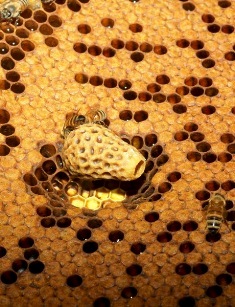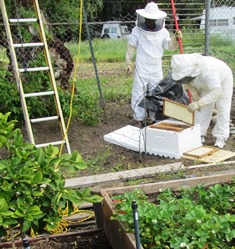Swarming Season Has Arrived!
What’s not to love about spring? It’s only the middle of April and already we’ve seen several honeybee swarms. Swarming is how the bees reproduce their colonies and most often occurs during the warm days of early spring.
My neighbor, whom I’ve often called a world-class beekeeper (his father kept honeybees in Lebanon and taught him well) permitted me to keep his bee swarm that alighted in my apricot tree. He also generously donated a super (hive box) with some frames that already had wax, honey, and capped brood–all from his own apiary.
The newly housed honeybee workers delight in foraging on the various types of lavender (Spanish, English, and French perfume) that I’ve planted around the farmette. The colony will build up the wax and make honey while the nursemaid bees will care for the brood.
My husband, the architect-turned-farmer/beekeeper, has constructed a unique bee house for the hives. It will keep the bee boxes dry during winter rains and out of reach of marauding animals (skunks and raccoons). Resting on a platform that Carlos built on top of a newly installed brick floor, the hives are not within easy reach of the ever present ant population.
Alas, the bees weren’t about to wait until Carlos finished building their house. The swarm happened when the bees were ready to take flight (some 60 percent of the workers with their old queen) flew into our apricot tree.
If you see a swarm, call your local beekeeping association (or any store that carries local honey) for the name of a beekeeper. Avoid the temptation of spraying water or anything else on the swarm. Permit the beekeeper to safely remove the swarm.
For a beekeeper, rescuing a swarm is a truly exhilarating experience. Often a swarm consists of thousands to tens of thousands of honeybees. Beekeepers routinely rescue swarms from where bees have temporarily clustered while the bee scouts seek a permanent home. The beekeeper can shake them into a prepared hive box, leaving the box at the hive cluster site until all the bees are inside. At that point, the beekeeper takes the new hive to his apiary.
The beleaguered honeybees (whose populations have been decimated by the Varroa mite, weakened immune systems, and Colony Collapse Disorder) need help to survive and increase their populations. We need them, too! Without their pollination of fruit, nut, and other crops, our own food sources diminish.
Saving the honeybees is a good practice whenever possible because doing so ensures abundance and diversity in the plants we eat. Whenever I see a cluster of bees in a tree I feel joyful and celebratory. Is it any wonder that swarming season is my favorite time of the year?
Honeybee Disorders and Diseases
The beleaguered honeybee is threatened from environmental stresses, pests, and diseases that not only can decimate the bees but continually challenge modern beekeepers who must figure out how best to treat the problems.
Beekeepers against the use of chemicals within the hive believe there are other options available for dealing with these challenges such as breeding stronger, more resistant bees. That can take years. Meanwhile, it is important to understand some of the problems that can assail a hive.
Chalkbrood
When you see a frame within the hive containing larvae that have turned chalky white, consider that you are likely dealing with chalkbrood. Infection is by a fungus, Ascosphaera apis, causing the larva to die after its cell has been capped. Only the larvae are susceptible. Healthy hives of bees can usually clean up the problem on their own. Re-queening the hive and rotating out the old comb comprise the best course of treatment.
Nosema
Nosema cerrane is a fungus infection of the adult bee, affecting the intestinal tract that results in diarrhea. The disease can weaken the bees and diminish the health of a hive. Heathy hives can usually fend off and recover from Nosema, but hives that are already week are more susceptible to Nosema infection.
Tracheal Mites
Tracheal mites infect the trachea (windpipe) of honeybees. Look for extended wings (when infected, bees are not able to fold their wings against their abdomens); missing wings, and dead bees on the ground outside of the hive.
Treatment consists of placing menthol crystals in the hive and leaving them for 14 days when temperatures at at 60 to 80 degrees Fahrenheit. The bees breathe in the menthol and mites die. Honey from medicated hives should not be consumed; frames for honey (for human consumption) can be put into the hive three to four weeks after medication is removed.
Alternatively, some beekeepers advocate using solid vegetable shortening and sugar patties, believing the bees eat the sugar and the shortening gets on their bodies making it difficult for mites to reproduce or attach to bees. A commercially available product Apiguard is also effective but must be used as directed. Do not treat when honey flow is on.
Most articles about treating bees with medications also warn that such treatments will contaminate the honey for human consumption and suggest treating bee colonies during certain times of the year, not treating during honey flows. Beekeepers are always advised to use medications according to instructions that come with them.
Varroa Mites
This external parasite of honeybees showed up in hives in the United States around 1980. Facing little resistance from American honeybees, it attacked adult and larvae, preferring drone (male) larvae to worker bee larvae. In addition to the mite’s direct attack on bees, it serves as a transmittor for viruses that can infect bees.
Treatment varies. One is to finely dust powdered sugar onto all the bees so the mite can no longer ling to the bees. Thus losing their grip, they fall off. Another treatment is to insert drone (male bee) comb. The mites prefer the drone larvae ( larger and develop over a longer period).
Once the mites infect the drone larvae, the drone comb is removed and put into a freezer, killing the mites. After a period of freezing, unseal the comb, return to the hive, and healthy worker bees will clean it.
Bee genetics might prove to be effective in the long run for dealing with the dreaded varroa mite. In the Primorsky region of Russia, a strain of bees have been found to be more than twice as tolerant to the varroa mite as conventional bee stocks and also more resistance to the tracheal mite. So after a period of quarantine, these Russian bees are available for commercial purpose in the United States.
Beekeepers can also control populations of mites using miticidal strips. These are hung inside the hive and must be handled and disposed of as hazardous material. Unfortunately, the mites are developing increasing resistance to the chemicals in miticides.
Foulbrood
The spore-forming bacterium Bacillus larvae is the most dreaded perhaps of all bee brood diseases–American foulbrood. European foulbrood is another brood disease of such highly infectious nature as to require the burning of the hive.
In American foulbrood, the bacterium infects larvae up to three days old producing millions of spores. Some bees are more susceptible to this highly communicable disease than others.
Teramycin (oxytetracycline) is the only drug approved to treat American Foulbrood Disorder. Many beekeepers use this drug annually as a prophylactic treatment for their hives. Once a hive is infected, burning the infected hive or hives is the only solution to stop the spreading since the spores can remain viable in honey and the beekeeping equipment for decades.
Note: Recommended reading: Top-Bar Beekeeping, Organic Practices for Honeybee Health, by Les Crowder and Heather Harrel (Chelsea Green Publishing 2012) and Keeping Bees and Making Honey, by Alison Benjamin and Brian McCallum (David and Charles Publishing 2008). See also, http://www.ars.usda.gov/Services/docs.htm?docid=2882
 Facebook
Facebook Goodreads
Goodreads LinkedIn
LinkedIn Meera Lester
Meera Lester Twitter
Twitter








